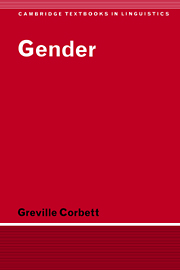Book contents
- Frontmatter
- Contents
- List of figures
- List of tables
- Preface
- List of abbreviations
- 1 INTRODUCTION
- 2 GENDER ASSIGNMENT I: SEMANTIC SYSTEMS
- 3 GENDER ASSIGNMENT II: FORMAL SYSTEMS
- 4 THE PSYCHOLINGUISTIC STATUS OF GENDER ASSIGNMENT
- 5 GENDER AGREEMENT
- 6 ESTABLISHING THE NUMBER OF GENDERS
- 7 TARGET GENDERS: SYNCRETISM AND ENFORCED GENDER FORMS
- 8 HYBRID NOUNS AND THE AGREEMENT HIERARCHY
- 9 GENDER RESOLUTION RULES
- 10 GENERALIZATIONS AND PROSPECTS
- References
- Author index
- Language index
- Subject index
2 - GENDER ASSIGNMENT I: SEMANTIC SYSTEMS
Published online by Cambridge University Press: 05 June 2012
- Frontmatter
- Contents
- List of figures
- List of tables
- Preface
- List of abbreviations
- 1 INTRODUCTION
- 2 GENDER ASSIGNMENT I: SEMANTIC SYSTEMS
- 3 GENDER ASSIGNMENT II: FORMAL SYSTEMS
- 4 THE PSYCHOLINGUISTIC STATUS OF GENDER ASSIGNMENT
- 5 GENDER AGREEMENT
- 6 ESTABLISHING THE NUMBER OF GENDERS
- 7 TARGET GENDERS: SYNCRETISM AND ENFORCED GENDER FORMS
- 8 HYBRID NOUNS AND THE AGREEMENT HIERARCHY
- 9 GENDER RESOLUTION RULES
- 10 GENERALIZATIONS AND PROSPECTS
- References
- Author index
- Language index
- Subject index
Summary
An intriguing question, which interests non-linguists as well as linguists, is the way in which nouns are allotted to different genders. The linguist who wishes to establish the gender of a given noun can use agreement as a test (for details see chapter 6). However, the native speaker of the language must know the gender of a noun in order to produce the correct agreements (the evidence which the linguist uses). The amount of information is substantial, since native speakers know the gender of many thousands of nouns. For foreign learners of the same language, in contrast, this knowledge often proves elusive in the extreme. How then does a native speaker know the gender of a particular noun? One possible answer would be that the speaker simply has to remember the gender of each noun. This suggestion would involve a considerable feat of memory. It seems an unlikely answer, though many linguists have been ready to accept it. For example, in an often quoted remark, Bloomfield (1933: 280) claimed that:
There seems to be no practical criterion by which the gender of a noun in German, French, or Latin could be determined.
This pessimism now appears misplaced in view of the following evidence. First, native speakers typically make few or no mistakes in the use of gender; if the gender of every noun were remembered individually, we would expect more errors. Second, words borrowed from other languages acquire a gender, which shows that there is a mechanism for assigning and not just remembering gender.
Information
- Type
- Chapter
- Information
- Gender , pp. 7 - 32Publisher: Cambridge University PressPrint publication year: 1991
